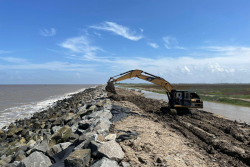Last week the Guardian’s Jerusalem correspondent visited a residential building in Sha’af that had been hit by a shell fired from an Israeli tank. As he inspected a hole punched through the wall, Peter Beaumont wrote that it “seems a small thing – a hole the size of a toaster.” The shell splintered as it moved through the living quarters of the three families, some 60 people in all, and “three pools of blood punctuate where three people died – two of them children.” A man carrying a purple plastic bag approaches Beaumont and opens it to reveals its grisly contents. “This was my son,” says Salem Antez, unable to say anything else.
Two days later, Beaumont visits the Shifa hospital following a “night of intense violence” in Shujai’iya, the most densely populated residential neighbourhood in Gaza City. While he is there, Beaumont watches as two young girls are brought in, “one with a bleeding head wound, another with her teeth smashed out, covered in dust. Another man had lost most of his face.” Beaumont learns from the director of the hospital that “at least 17 children, 24 women and four elderly” have died so far in the military action. Four hundred others have been wounded.
It is impossible to read accounts like these without marvelling at how differently the war in Gaza has been handled by the US media. The absence of comparable broadcast media footage has allowed Israel’s repeated violations of the Geneva Convention prohibitions on targeting civilians to be downplayed in US coverage of the conflict. Consequently, much of the violence that has claimed more than 800 Palestinian lives – three quarters of them civilians, according to the United Nations– remains an abstraction to American viewers and readers. In the abbreviated coverage aired on most US television networks little has been done to highlight the glaring discrepancy between the projection of force by Hamas’ rocket strikes, which, while reprehensible, are often either ineffectual or neutralized by Israel’s hi-tech ‘Iron Dome’ defence, and Israel’s vastly more destructive campaign against Palestinian houses and civilians.
Instead of focusing on the human cost of Israel’s overwhelming military force, the US media has tended to treat the conflict as though it were one between evenly matched adversaries. The New York Times, for instance, keeps a running tally of “targets in Gaza struck by Israel” and “rockets launched at Israel from Gaza.” Implicit in this score-keeping are ideas that elsewhere become explicit, namely that Israel, which fires at “targets” is committed to “protecting civilians” while Hamas, which fires at “Israel,” continues to operate with unlimited and indiscriminate aggression.
Israel’s incursion into Gaza has been presented as “self-defence” but the lopsided body counts indicate otherwise. More importantly, the rationale is self-defeating for the current violence will only serve to further radicalize opposition to Israel and exacerbate problems that have undermined previous efforts to sustain a modicum of normal life into the territory. In an Op-Ed for the New York Times, a reporter for The Washington Report on Middle East Affairs notes that “the long siege has bled the Gaza Strip dry. There is no money for public services [and] the majority of the population lives in abject poverty… at least 120,000 Gazans have been displaced [and many] will return to homes damaged or destroyed, with little or no means to rebuild.” This is the grim reality that will endure long after the international community patches together another makeshift peace deal.
There is no need to simplify Israel’s complex history, nor the many failed negotiations, interventions and roadmaps that have led to the current situation in order to condemn the carnage in Gaza. The longer the violence lasts, the more entrenched hard-liners on both sides become, and their rise makes a viable peace deal – even the increasingly inevitable two-state solution – even less likely. In 1957 Golda Meir told the National Press Club in Washington that “Peace will come when the Arabs will love their children more than they hate us.” In view of what is currently taking place, it would be more accurate to say that the appalling and utterly unnecessary deaths of so many Arab children are guaranteed to make the situation far worse.






